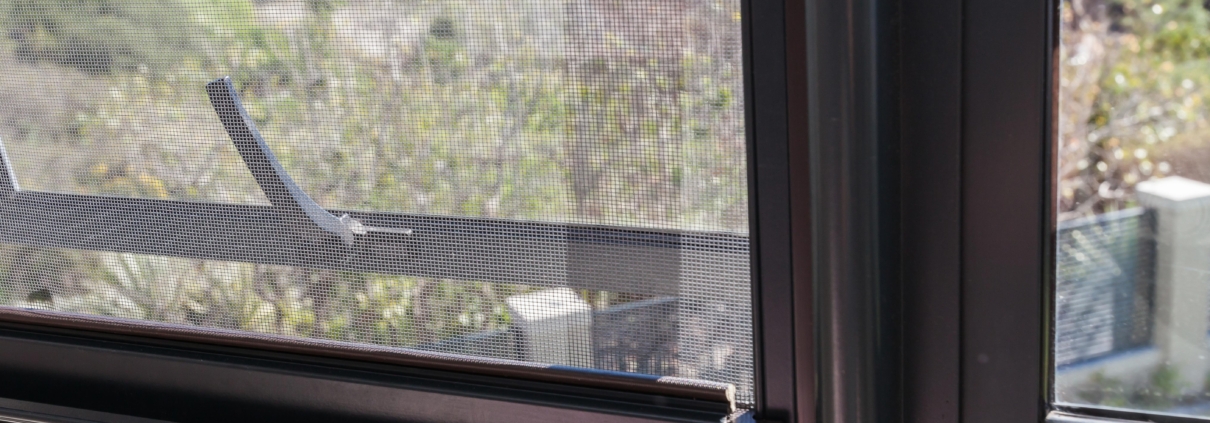Flyscreen Prices: The Cost of Insect-Proofing Your Home
Flyscreen prices depend on a few factors. Is it for a door or window? What’s the size of the opening? What type of application is it; rollerscreen, sash-type, hinged or sliding? Ordinary insect mesh or pet mesh?
Request a Flyscreen Quote
If you want to know how much an insect screen will cost, it’s best to contact us and request a quote. Provide us with the width and height of the opening and a few other details and we’ll work out a budgetary quote for you.
And then, if you decide to go ahead with an order, we’ll send one of our sales reps out to take the final measurements.
A Note About “Standard Sizes’

You might think your kitchen door or bathroom window is a ‘standard size’, but it’s not as simple as that. There are hundreds of combinations of various widths and lengths with windows. This article, from a German window manufacturer, provides an overview of window sizes.
And windows come in many styles: top-hung, side-hung, sliding or even sash-type. So we’ve developed flyscreen applications to accommodate the different windows.
There are fewer standard door sizes. And doors also come in different styles, such as hinged, sliding or stacking.
Measurements are most important, but there are other factors to consider.
What Factors Affect the Price of a Flyscreen?
Once we have the measurements and we know what style of window or door you have, we’ll need to know the following:
-
WHAT MATERIAL IS YOUR WINDOW OR DOOR?
Wood, steel and aluminium are the three most common materials used to make windows and doors. Why do we need to know this? It’s because some of our insect screens are better suited to certain types of windows. For example, our Sash-Type screens are best suited to steel-framed windows.
-
DO YOU HAVE BLINDS, BURGLAR BARS OR SECURITY GATES?
Our insect screens attach to your window or frame to create a seal. Without it, insects could slip through the gaps, defeating the purpose of the screen.
We can work around barriers such as burglar bars and security gates. That usually requires extra material to create a frame we can attach the screen to. Or, if you have blinds, we’ll charge you a fee for repositioning them.
-
WHAT ABOUT PLASTER OR TILES?

Plaster and tiles affect the measurements of your opening.
For example, the window in a bathroom or kitchen might only have tiles halfway up the recess. As a result, the width will be different at the top compared to the bottom of the opening. So, before we manufacture your screens, a sales rep will come out to measure each window.
-
DO YOU HAVE ENOUGH RECESS SPACE?
The ‘recess’ refers to the depth of space between the front of the wall and the window or door. Our screens form part of your existing openings but each application requires a certain amount of space.
For example, our Rollerscreen Flyscreens have a cassette or tube that holds the mesh when it’s rolled up. The cassette measures 45 mm in diameter, so the recess must be at least 45 mm deep to fit the tube. Of course, we can attach the screen to the wall in front of the window (called a face-fix). That requires more material and will increase the total cost.
-
STANDARD OR CUSTOM COLOUR?
All our screens have powder-coated aluminium frames. Match your insect screens to your window or door frames and they’ll be even less noticeable. The powder-coating finish also protects the aluminium frame and increases its durability.
Our standard powder-coating colours are white, cream, beige, bronze, charcoal or black. Other colours are available but come with a surcharge.
Insect Screen Applications & Costs
Keep in mind that our flyscreen prices are subject to change. The cost of materials, transport, and other factors fluctuate almost weekly. And remember that these prices do not include VAT or installation.
Sash-Type Flyscreens
A sash-type screen consists of two panels of mesh within an aluminium frame. One panel is stationary while the other moves up and down or left to right.
Sash-type insect screens are only suitable for windows and not doors.

Price Range: R600 – R1600 (excl. VAT & Installation)
Rollerscreen Flyscreens
Like a roller blind, the insect mesh in a Rolllerscreen Flyscreen rolls up into a tube. This application is suitable for both doors and windows.

R900 – R1 800 for a Rollscreen Window (excl. VAT & Installation)
R1 500 – R2 300 for a Rollscreen Door (excl. VAT & Installation)
Solid-Hinged Screens
Solid-hinged insect screens consist of an aluminium frame with mesh stretched across it. They attach to the window or door frame on a hinge. To access your window handle, you open the screen by pulling it towards you. Then, once the window is open, the screen shuts over the window. A magnetic lock keeps the screen in place.
 Price Range:
Price Range:
R900 – R1900 for a Lightweight Solid-Hinged Window (excl. VAT & Installation)
R2200 – R4000 for a Lightweight Solid-Hinged Door(excl. VAT & Installation)
Solid-Slider Screen
Our sliding screens complement sliding doors and windows. You can install the screen inside or outside of the existing frame.
Price Range:
Solid Slider Window Screen: R1400 – R2600 (excl. VAT & Installation)
Solid Slider Door Screen: R1900 – R3200 (excl. VAT & Installation)

Flyscreens Are An Investment
A custom-made flyscreen is an investment. It’s made from quality materials and designed to form part of your existing windows. The screen is permanently attached and will last you a lifetime.
You don’t need to buy insect screens for all your windows at once. Let our consultants help you find a cost-effective way to insect-proof your home.
Remember, the flyscreen prices above do not include VAT or installation costs. Please don’t hesitate to contact us for a quote or if you have any questions about our flyscreens. We’re more than happy to discuss your requirements and provide you with an accurate quote.




